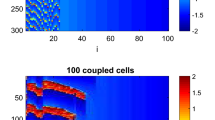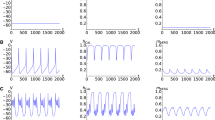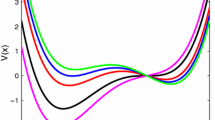Abstract
The interaction of a pair of weakly coupled biological bursters is examined. Bursting refers to oscillations in which an observable slowly alternates between phases of relative quiescence and rapid oscillatory behavior. The motivation for this work is to understand the role of electrical coupling in promoting the synchronization of bursting electrical activity (BEA) observed in the β-cells of the islet of Langerhans, which secrete insulin in response to glucose. By studying the coupled fast subsystem of a model of BEA, we focus on the interaction that occurs during the rapid oscillatory phase. Coupling is weak, diffusive and non-scalar. In addition, non-identical oscillators are permitted. Using perturbation methods with the assumption that the uncoupled oscillators are near a Hopf bifurcation, a reduced system of equations is obtained. A detailed bifurcation study of this reduced system reveals a variety of patterns but suggests that asymmetrically phase-locked solutions are the most typical. Finally, the results are applied to the unreduced full bursting system and used to predict the burst pattern for a pair of cells with a given coupling strength and degree of heterogeneity.
Similar content being viewed by others
References
Aronson, D. G., G. B. Ermentrout and N. Kopell (1990). Amplitude response of coupled oscillators. Physica D 41, 403–449.
Bar-Eli, K. (1984). Coupling of chemical oscillators. J. Phys. Chem. 88, 3616–3622.
Bar-Eli, K. (1985). On the stability of coupled chemical oscillators. Physica D 14, 242–252.
Bertram, R., P. Smolen, A. Sherman, D. Mears, I. Atwater, F. Martin and B. Soria (1995). A role for calcium release-activated current (CRAC) in cholinergic modulation of electrical activity in pancreatic β-cells. Biophys. J. 68, 2323–2332.
Doedel, E. (1981). AUTO: a program for the automatic bifurcation analysis of autonomous systems. Cong. Num. 30, 265–284.
Eddlestone, G. T., A. Goncalves, J. A. Bangham and E. Rojas (1984). Electrical coupling between cells in islets of Langerhans in mouse. J. Membr. Biol. 77, 1–14.
Ermentrout B. (1981a). Unpublished lecture notes.
Ermentrout, B. (1981b). n:m Phase-locking of weakly coupled oscillators. J. Math. Biology 12, 327–342.
Ermentrout, B. and N. Kopell (1990). Oscillator death in systems of coupled neural oscillators. SIAM J. Appl. Math. 50, 125–146.
Han, S. K., C. Kurrer and Y. Kuramoto (1995). Dephasing and bursting in coupled neural oscillators. Phys. Rev. Lett. 75, 3190–3193.
Hindmarsh, J. L. and R. M. Rose (1984). A model of neuronal bursting using three coupled first order differential equations. Proc. R. Soc. Lond. B 221, 87–102.
Kawato, M., M. Sokabe and R. Suzuki (1979). Synergism and antagonism of neurons caused by an electrical synapse. Biol. Cybernetics 34, 81–89.
Keener, J. P. (1988). Principles of Applied Mathematics. Redwood City, CA: Addison-Wesley Publishing Company.
Khibnik, A. I., Y. A. Kuznetsov, V. V. Levitin and E. V. Nikolaev (1993). Continuation techniques and interactive software for bifurcation analysis and interate maps. Physica D 62, 360–371.
Kuramoto, Y. (1984). Chemical Oscillations, Waves, and Turbulence. Berlin: Springer.
Li Y.-X. (1990). Conditions for the occurrence of degeneracy between Turing and phase instabilities. Phys. Lett. A 147, 204–208.
Manor, Y., J. Rinzel, I. Segev and Y. Yarom (1997). Low-amplitude oscillations in the inferior olive: a model based on electrical coupling of neurons with heterogeneous channel densities. J. Neurophysiol. 77, 2736–2752.
Meda, P., I. Atwater, A. Bangham, L. Orci and E. Rojas (1984). The topography of electrical synchrony among β-cells in the mouse islet of Langerhans. Q. J. Exp. Physiol. 69, 719–735.
Meda, P., R. M. Santos and I. Atwater (1986). Direct identification of electrophysiologically monitored cells within intact mouse islets of Langerhans. Diabetes 35, 232–236.
Michaels, R. L., R. L. Sorenson, J. A. Parsons and J. D. Sheridan (1987). Prolactin enhances cell-to-cell communication among β-cells in pancreatic islets. Diabetes 36, 1098–1102.
Morita, Y. (1986). A secondary bifurcation problem of weakly coupled oscillators with time delay. Japan. J. Appl. Math. 3, 223–247.
Morita, Y. (1987). A periodic wave and its stability to a circular chain of weakly coupled oscillators. SIAM J. Math. Anal. 18, 1681–1698.
Morris C. and H. Lecar (1981). Voltage oscillations in the barnacle giant muscle fiber. Biophys. J. 35, 193–213.
Perez-Armendariz, M., D. C. Spray and M. V. L. Bennett (1991). Biophysical properties of gap junctions between freshly dispersed pairs of mouse pancreatic beta cells. Biophys. J. 59, 76–92.
Pernarowski, M. (1998). Fast and slow subsystems for a continuum model of bursting activity. SIAM J. Appl. Math. In press.
Rinzel, J. (1985). Bursting oscillations in an excitable membrane model, in Ordinary and Partial Differential Equations, Lecture Notes in Mathematics, Vol. 1151, B. D. Sleeman and R. J. Jarvis (Eds), New York: Springer, pp. 304–316.
Sherman, A. (1994). Anti-phase, asymmetric and aperiodic oscillations in excitable cells-I. coupled bursters. Bull. Math. Biol. 56, 811–835.
Sherman, A. (1995). Theoretical aspects of synchronized bursting in β-cells, in Pacemaker Activity and Intercellular Communication, J. D. Huizinga (Ed.), Boca Raton, FL: CRC Press, pp. 323–337.
Sherman, A. (1996). Contributions of modeling to understanding stimulus-secretion coupling in pancreatic β-cells. Am. J. Physiol. 271, E362–E372.
Sherman, A. and J. Rinzel (1991). Model for synchronization of pancreatic β-cells by gap junctions. Biophys. J. 59, 547–559.
Sherman, A. and J. Rinzel (1992). Rhythmogenic effects of weak electrotonic coupling in neuronal models. Proc. Natl Acad. Sci. USA 89, 2471–2474.
Smolen, P. and J. Keizer (1992). Slow voltage inactivation of Ca2+ currents and bursting mechanisms for the mouse pancreatic beta-cell. Biophys. J. 127, 9–19.
Smolen, P., J. Rinzel and A. Sherman (1993). Why pancreatic islets burst but single β cells do not: the heterogeneity hypothesis. Biophys. J. 64, 1668–1680.
Taylor, M. A. and I. G. Kevrekidis (1991). Some common dynamic features of coupled reacting systems. Physica D 51, 274–292.
Taylor, M. A. and I. G. Kevrekidis (1991). Couple, double, toil and trouble: a computer assisted study of two coupled CSTRs. Chemical Engineering Science 48, 2129–2149.
Valdeolmillos, M., A. Gomis and J. V. Sanchez-Andres (1996). In vivo synchronous membrane potential oscillations in mouse pancreatic beta-cells: lack of co-ordination between islets. J. Physiol. 493, 9–18.
Wang X.-J. and J. Rinzel (1995). Oscillatory and bursting properties of neurons, in The Handbook of Brain Theory and Neural Networks, M. A. Arbib (Ed.), Cambridge, MA: The MIT Press, 686–691.
Yamaguchi Y. and H. Shimizu (1984). Theory of self-organization in the presence of native frequency distributions and external noise. Physica D 11, 212–226.
Author information
Authors and Affiliations
Additional information
An erratum to this article is available at http://dx.doi.org/10.1006/bulm.1999.0125.
Rights and permissions
About this article
Cite this article
De Vries, G., Sherman, A. & Zhu, HR. Diffusively coupled bursters: Effects of cell heterogeneity. Bull. Math. Biol. 60, 1167–1200 (1998). https://doi.org/10.1006/bulm.1998.0057
Received:
Accepted:
Issue Date:
DOI: https://doi.org/10.1006/bulm.1998.0057




